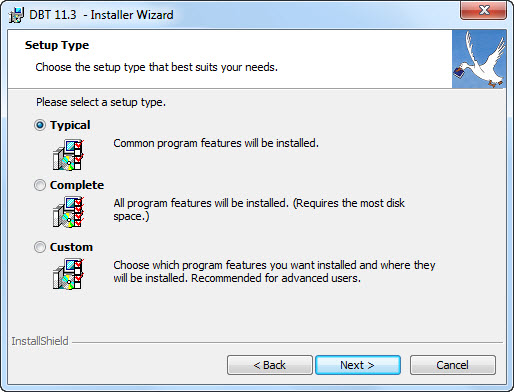
Before reading this topic, be sure that you have read and understood all the instructions for Simple Installation. That topic includes full instructions for the simplest (and most common) type of DBT installation. This topic, in contrast, does not give full instructions for a more complex installation, but simply explains how to modify the Simple Installation steps to customize your installation.
There are three different ways to modify the Simple Installation instructions covered here. You can easily elect to:
Each of these customizations is covered in a separate section below.
If this is all you want to do, the first thing to do is reconsider. The Simple Installation procedure in fact installs all or nearly all features anyhow. The only features you're likely to miss this way are the French Braille Fonts, which are not generally of interest outside of French-speaking nations.
However, if you want to be absolutely certain that everything is installed, then simply click Complete, or type Alt+C, when you see this screen (in step 4 of the Simple Installation instructions):

The remainder of the installation proceeds just as it does in the Simple Installation instructions.
Note: If you want to install all features and change the installation or activation storage directory, then you must instead follow the steps below for Customization 4: Customize what features are installed, then simply elect to install each and every feature. This is necessary because you can modify the installation directories only if you select Custom in the dialog shown above.
Most of the files that the installer puts on your system are placed into a single folder, typically C:\Program Files\Duxbury Systems, Inc.\DBT 12.2, for 32-bit computers. (On 64-bit machines, the typical folder is, C:\Program Files (x86)\Duxbury Systems, Inc.\12.2 SR1. ) If the default location for this folder does not suit you, you can change it.
First, when you see the dialog shown above (in step 4 of the Simple Installation instructions), you must click Custom, or type Alt+S, before clicking Next, or typing Alt+N or Enter. By doing this, you cause the installer to insert two extra dialogs in the installation sequence.
Note: If you do not alter any of the settings in either of these two installation dialogs, then the result is exactly the same as if you had followed the Simple Installation instructions without elaboration. That is, the result is a "Typical" installation.
The first extra dialog, which allows you to change where the software is installed, is shown here:
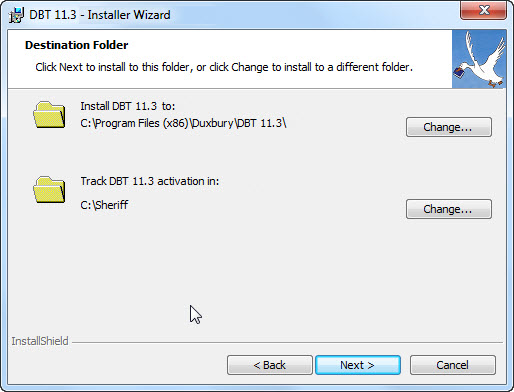
If you want to change where the software is installed, click on the first Change button, or type the Tab key until you reach it, then strike the Spacebar. You will then see a dialog like this one:
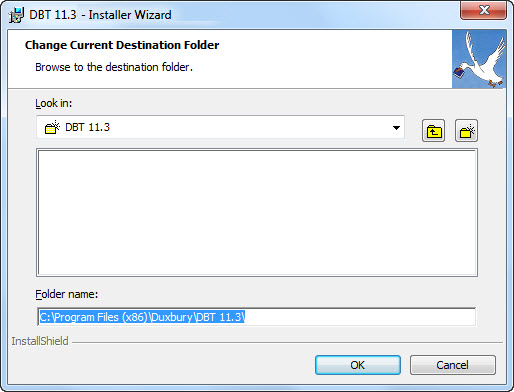
If you wish, you can use the drop-down list at the top of the dialog to review the name of the current destination folder, and see the hierarchy of folders in which it will be created. (Note: the radiating lines shown in the folder icon to the left of "DBT #.#" in the image shown above indicate that this will be a new folder.)
You can also use the Parent Folder and Create New Folder tool buttons that appear to the right of the drop-down list.
However, it may be simpler to use the editable text control near the bottom of the dialog. This shows the full path to the folder proposed as a destination for DBT 12.2. In our case, this control would contain the text "c:\Program Files (x86)\Duxbury\DBT 12.2". Similar text is highlighted in the example shown above, which indicates that it is selected. The text is already highlighted when the dialog appears. So be careful, because any text that you type will replace the entire proposed destination path. To avoid losing the whole path, we recommend using an arrow key, or perhaps the Home key, if you just want to change the drive letter, before you start editing the text of this control. (Note: If you make a mistake, press Escape, or click the Cancel button, then push Spacebar again, or re-click the Change button in the Destination Folder dialog, to return to this dialog with the path once again displayed.)
The path that you specify does not need to exist. The installer will create the destination folder for you as well as any parent folders required. However, you do need to have sufficient operating privileges on the computer in order to create these folders.
When you have finished modifying the destination folder, click the OK button or type Enter. You return to the Destination Folder dialog, which will now reflect the new destination you specified. Click Next, or type Alt+N, to continue. Or, if you wish to change the folder for the DBT activation files, then read on.
Note: While the Change Destination Folder dialog remains active, the Installer periodically checks to be sure that you're specifying a valid location — either an existing folder to which you can write files, or a path that you can create. It also checks this when you click OK to dismiss the dialog. If the path is not valid, the installer might pop up an error message like this one:
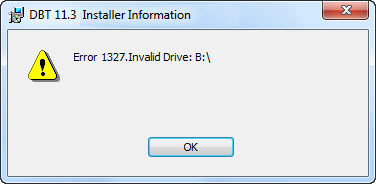
You can dismiss any such error message easily enough by clicking OK or pressing Enter. The Installer may or may not then immediately "fix" your mistake by resetting the text of the Folder Name to what it was when the dialog first appeared. Watch out for that.
In order to become activated, DBT needs to store several activation files on your hard drive. These files are stored separately from your DBT software because, unlike the program files, which are normally in a read-only directory, the activation files must be placed in a folder that is writable by any person running DBT. DBT normally places the activation folder at C:\Sheriff.
If you need to change the location of the activation files, follow the procedures as above for changing where the software is installed, but use the second Change button in the Destination Folder dialog instead of the first. Be sure that you specify a location that your end users can read and write.
Note: If you make this change while updating or modifying a previous 12.2 SR1 installation, then the installer might need to deactivate DBT before relocating the activation files. It will do this automatically, but this will leave your software deactivated. So, you'll have to activate again when you next run DBT.
When you select a Custom installation, the Destination Folder dialog required to change the location where DBT itself or its activation files are stored is but the first of two dialogs that the installer inserts into the normal sequence. The second of these two dialogs is used to choose specific features to be installed. It looks like this:
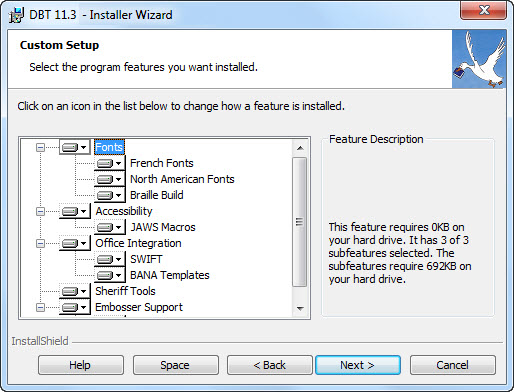
The most important part of this dialog is the tree control, on the left side of the dialog. This shows which features are currently selected, and can be used to select or de-select other features for installation.
The tree control shows only the name of each feature. Unfortunately that may not always tell you enough about it to know whether you want it installed. For certain select items in the tree control, additional information is displayed in the "Feature Description" column of the dialog, to the right of the tree control. For these items (like Sheriff Tools), you can read this information to learn more. Note that you can not de-select the basic features of DBT, so you can not create an installation that will not work.
The following keys can be used within the tree control:
When the Feature Selection dialog is first displayed, all feature groups are expanded, so all individual features are showing. Moreover, most or all features are selected for installation.
To de-select a particular feature, navigate to it in the tree control, using the keystrokes shown above, or by clicking on the feature with the mouse. Then push Spacebar or right click on the feature with the mouse. A menu will pop up, as shown here:
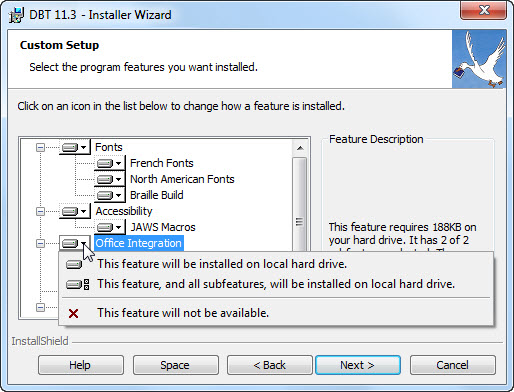
The pop-up menu contains these choices:
If you bring up the pop-up menu for a feature and decide that you do not want to change it, you can dismiss the pop-up by striking the Escape key. Either Escape or Enter will dismiss the menu, but Enter may change whether the feature is to be installed.
When you are done making your selections, click the Next button, or type Alt+N, to continue.
The other buttons at the bottom of the dialog are typically not necessary to use. The Back and Cancel buttons serve their usual functions. The Help and Space buttons both bring up informational dialogs. The Help dialog explains what the different choices in the pop-up menu mean, and what the icon associated with each choice looks like. But it does not tell you that setting a feature to run from the network is not supported by DBT. The Space dialog lists the computer hard drives and how much space is available on each. It highlights any hard drive that does not have enough space to install DBT. So if you are tight on space, you can use that dialog to explore where there might be room for DBT. Note also that de-selecting features for installation will reduce the space needed for the installation.